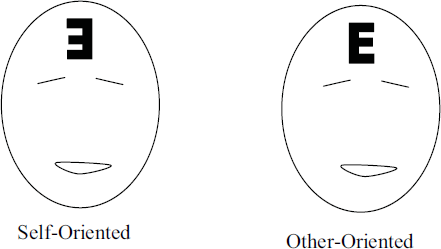Book summary of
To Sell is Human
The Surprising Truth About Moving Others

If you think about it, you are a salesman. Much of what you do involves moving others. This summary will help you become more effective at it.
You spend a big portion of your time selling in a broader sense; Trying to convince someone about your opinion, pitch your idea to a colleague or persuade people to read your article.
The ABCs of moving others are:
- A – Attunement
- B – Buoyancy
- C – Clarity
Attunement
Do you have the capability to step outside your own experience and imagine the emotions, perceptions, and motivations of another?
Go ahead and ask someone in the room with you to snap their fingers five times as quickly as they can. Then use their hand to draw a capital E on their forehead. Do they draw it so they could read it, or that you can read it?

- Reduce your power: Power leads individuals to anchor too heavily on their own vantage point, and not adjust enough to the other’s perspectives. Try to assume you’re not the one with the power.
- Train for perspective-taking: Always try to take the perspective of the other person and put yourself in their shoes.
- Practice strategic mimicry: Without realizing it, we often do what others do; Mirror back speech patterns, facial expressions, and behaviors. When we’re talking to crosser her arms; we do the same. It’s a natural act that serves as a social glue and a sign of trust. It’s proved to be effective. Try it in a subtle way next time you talk with someone.
- Try to be an ambivert: Contrary to popular belief, the most successful salesmen aren’t extroverts, they’re ambiverts. Extroverts often stumble over themselves. They talk too much and listen too little. Introverts are too shy to initiate and too timid to close. Selling requires a balance of introvert’s inspection and extroverts responding. If you’re an extrovert, try to make fewer declarations and ask more questions. Talk less and listen more. If you’re an introvert, practice your “ask” in advance. Make a conscious effort to smile and sit up straight.
- Find commonalities: We’re more likely to be persuaded by those we like. One reason we like people is that they remind us of ourselves.
Buoyancy
Whether you’re trying to convince customers to make a purchase or colleagues to make a change, you must contend with wave after wave of refusals. You should consider the nos you’re getting as just part of the process.
- Practice interrogative self-talk: Positive self-talk is generally more effective than negative self-talk, but neither are the best. Mere affirmations feel good, but it doesn’t help you accomplish the task. The best self-talk is to ask yourself: Can we fix it? Interrogative self-talk by its very form elicits answers, which helps you to actually carry out the task.
- Monitor your positivity ratio: Negative emotions evolved to narrow people’s vision and propel their behavior toward survival at the moment. Positive emotions do the opposite: They broaden people’s ideas about possible actions. It makes us more receptive and more creative. Positivity during a sales encounter infects the buyer. It makes them less adversarial and more open to possibility and reaching an agreement. But positivity doesn’t mean coating with a thick glaze of sugar. The golden ratio ranges from (3 to 1) to (11 to 1)
- Tweak your explanatory self-talk: When confronted with rejections, getting into the habit of explaining negative events to yourself can help you avoid learned helplessness. Try to explain bad events as temporary, specific and external rather than permanent, pervasive, and personal. Optimism is a catalyst that can stir persistence.
Clarity
Clarity is the capacity to help others see their situations in fresh and more revealing ways and to identify problems they didn’t realize they had. Today both sales and non-sales selling depend more on creative problem-finding skills of the creative rather than on the problem-solving skills the technician.
In the past, the best salespeople were good at accessing information. Today, they must be skilled at curating it. The best salespeople were good at answering questions. Today, they should be good at asking questions, uncovering possibilities and finding unexpected problems.
- Add contrast: Instead of trying to get donations through a sign that says “I am blind.” Adding four words will dramatically help: “It is springtime and I am blind.”
- Reduce options: You can make the choice much easier by reducing options and avoiding confusion.
- Focus on experience: Framing a sale in experiential terms will lead to more satisfied customers. If you’re selling a car, focus on places they’d visit rather than the leather on the seats.
- Blemish your pitch: People who get a small dose of negative information are more likely to purchase that who receive exclusively positive info. Being honest about the existence of a small blemish can enhance your offering’s true beauty.
- Show your potential Our initial instinct is to use an achievement frame. What we really should do is to emphasize our potential. “I could be the next big thing” is more effective than “I am the next big thing”
- Be clear on how to act: Be extremely clear on how you want people to act.
- Ask the Five whys: When you want to figure out what kind of problem someone has, ask a why question, then in response to your answer, ask another why? And again till they’re five.
- Find the one percent: You don’t remember much about the peculiars of what you learned in class. But you do remember one percent. To understand anything, the key is to focus on the “one-percent.” Don’t get lost in details and find the essence of what you’re exploring. If you can convey the one-percent to others, they’re likely to be moved.
Ask better questions:
Before your next sales call, a meeting with your annoying boss, or awkward meeting with your ex-spouse, try this technique:
- Produce questions: Write down as many questions as you can, without stopping to judge or answer
- Improve them: Go through the list and categorize them as closed-ended or open-ended (could be answered with a yes or no or not)
- Prioritize them: Choose your three most important questions and edit them so they are ultra-clear.
Pitch
Pitching is the ability to distill one’s point to its persuasive essence. You don’t need to push your idea on the catcher; if the catcher feels like a creative collaborator, the odds of rejection diminish. The purpose of a pitch isn’t necessarily to move others immediately to adopt your idea. The purpose is to offer something so compelling that it begins a conversation and brings the other person as a participant.
- One word pitch: The ultimate pitch for short attention spans can be one word. It forces clarity. Think no-code.
- The question pitch: When you make a statement, you can receive it passively. When I ask a question, you’re compelled to respond.
- The rhyming pitch: Remember: pitches that rhyme are more sublime.
- The subject-line pitch: Every e-mail we send is a pitch. It’s a plea for your attention and an invitation to engage. People are more likely to read emails that directly affect their work, and that have moderate levels of uncertainty about the contents. Also being ultra-specific helps. “Improve your golf swing” is worse than “4 tips to improve your golf swing this afternoon.”
- The twitter pitch: Practice writing your pitch in a 140 character tweet.
- The Pixar pitch: Write your pitch as a story: Once upon a time __. Every day, __. One day __. Because of that, __. Until finally __.
5 pitching tips you can try today!
- Make sure your pitch gets three things right: What do you want them to know? What do you want them to feel? What do you want them to do?
- Add a visual or video
- Experiment with 20 slides
- Go first if you’re the incumbent. Last if you’re the challenger
- Granular numbers are more credible. Up to 120 minutes is better up to 2 hours
Improvise
Sales and theater have so much in common. Both take guts, and both invite rejection. Scripts perform nicely in predictable environments - when buyers have minimal choices and sellers have maximum information. But this is now rare. Improvisation works better in dynamic and unpredictable conditions. There are three rules of improvisational theater:
- Hear offers
- Say “Yes and.”
- Make your partner look good.
Hear offers
You can take in anything and everything that someone says as an offer you can do something with. What seems like objections are often offers in disguise. Hearing offers hinges on attunement: leaving your own perspective to inhabit the perspective of another. Listening without some degree of intimacy isn’t really listening.
Say “Yes and.”
“Yes but” is the evil twin of “Yes and” Your response to “let’s have our high school reunion in Las Vegas.” Shouldn’t be “Yes, but that’s going to be too expensive for some people.” It should be “Yes, and if it’s too expensive for some people, we can raise money or organize road trips.” Instead of swirling downward into frustration, “Yes and” spirals upward toward possibility.
Make your partner look good.
The aim of negotiating shouldn’t be to make the other side lose but, where possible, to help it win. The only way to truly influence others is to adopt a frame of mind and heart that constantly seeks mutual benefit in all human interactions. Pushing towards win-lose often ends in lose-lose. Making your partner look good doesn’t make you look worse; it actually makes you look better.
Serve
Make it personal
In the name of professionalism, we often neglect the human element and adopt a stance that’s abstract and distant. Instead, we should recalibrate our approach so that it’s more concrete and personal. Make your customers know that there is a real person behind the service who actually cares if they’re happy.
Make it purposeful
While we often assume that human beings are motivated mainly by self-interest, a stack of research has shown that all of us also do things that are “prosocial” and “self-transcending.”
Be emotionally intelligent

This sign is effective at moving people because it expresses empathy with the person viewing it. It’s personal and purposeful.


























